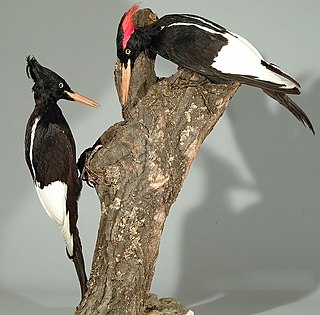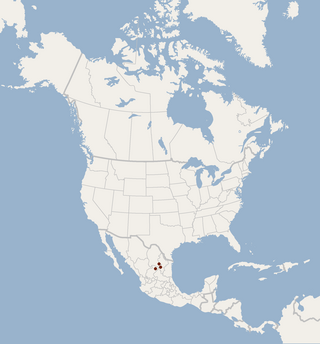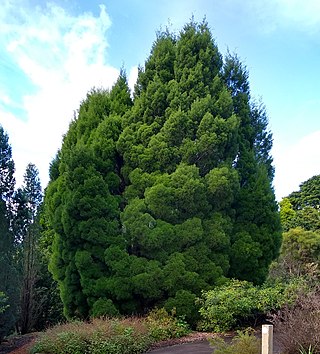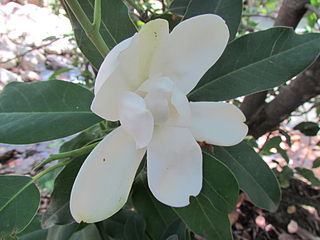
The imperial woodpecker is a woodpecker species endemic to Mexico. If it is not extinct, it is the world's largest woodpecker species, at 56–60 cm (22–23.5 in) long. Researchers have discovered that the imperial woodpecker has slow climbing strides and a fast wing-flap rate compared with other woodpeckers. Owing to its close taxonomic relationship, and its similarity in appearance, to the ivory-billed woodpecker, it is sometimes called the Mexican ivory-billed woodpecker, but this name is also used for the extant pale-billed woodpecker. The large and conspicuous bird has long been known to the native inhabitants of Mexico and was called cuauhtotomomi in Nahuatl, uagam by the Tepehuán and cumecócari by the Tarahumara.
Sierra Madre may refer to:

The Sierra Madre Occidental is a major mountain range system of the North American Cordillera, that runs northwest–southeast through northwestern and western Mexico, and along the Gulf of California. The Sierra Madre is part of the American Cordillera, a chain of mountain ranges (cordillera) that consist of an almost continuous sequence that form the western "sounds" of North America, Central America, South America, and West Antarctica.

The Mexican jay formerly known as the gray-breasted jay, is a New World jay native to the Sierra Madre Oriental, Sierra Madre Occidental, and Central Plateau of Mexico and parts of the southwestern United States. In May 2011, the American Ornithologists' Union voted to split the Mexican jay into two species, one retaining the common name Mexican jay and one called the Transvolcanic jay. The Mexican jay is a medium-sized jay with blue upper parts and pale gray underparts. It resembles the Woodhouse's scrub-jay, but has an unstreaked throat and breast. It feeds largely on acorns and pine nuts, but includes many other plant and animal foods in its diet. It has a cooperative breeding system where the parents are assisted by other birds to raise their young. This is a common species with a wide range and the International Union for Conservation of Nature has rated its conservation status as being of "least concern".

The Sierra Madre Occidental pine–oak forests are a Temperate broadleaf and mixed forests ecoregion of the Sierra Madre Occidental range from the southwest USA region to the western part of Mexico. They are home to a large number of endemic plants and important habitat for wildlife.

The Hispaniolan crossbill is a crossbill that is endemic to the island of Hispaniola, and the only representative of the Loxia genus in the Caribbean.

Iztaccíhuatl–Popocatépetl National Park, also known as Izta-Popo Zoquiapan National Park, is a national park in Mexico on the border of the states of México, Puebla, and Morelos. The park protects 39,819.08 hectares, surrounding Mexico's second- and third-highest peaks, the Popocatépetl and Iztaccíhuatl volcanoes as well as the area of the Hacienda de Zoquiapán, and its annexed areas (anexas) of Zoquiapan, Ixtlahuacán, and the Frío de Juárez River.

New World sparrows are a group of mainly New World passerine birds, forming the family Passerellidae. They are seed-eating birds with conical bills, brown or gray in color, and many species have distinctive head patterns.

The flat-headed myotis is a species of vesper bat. It is endemic to Mexico where it is found in certain montane forests in the Sierra Madre Oriental in the northeast of the country. Once thought to be extinct, this bat was rediscovered in 2004 by Joaquín Arroyo-Cabrales and colleagues. The species is now classified as endangered by the IUCN.

Callitris baileyi is a species of conifer in the family Cupressaceae. It is found only in Australia, more specifically Southeast Queensland. Its common English name is Bailey's cypress-pine. The name is dedicated to Australian botanist Frederick Manson Bailey, who was the first to collect specimens of this tree. Bailey's name is closely associated with much of the flora of Queensland and their elucidation in Southeastern Queensland. Over the past few decades the conifer has been severely threatened by habitat loss Fruiting for the species has been recorded year-round.

Quercus conzattii is an oak endemic to Mexico. It is placed in Quercus section Lobatae.

Quercus uxoris is an uncommon species of oak.

The Trans-Mexican Volcanic Belt pine–oak forests is a subtropical coniferous forest ecoregion of the Trans-Mexican Volcanic Belt of central Mexico.

The Zacatonal is a montane grassland and shrubland ecoregion of central Mexico.

Magnolia pacifica is a species of Magnolia from Jalisco and Nayarit states in western Mexico.
Quercus radiata is an endangered species of oak native to Mexico.
The Sierra los Huicholes is a mountain range in western Mexico. It is located in the states of Nayarit, Jalisco, and Zacatecas. The Sierra los Huicholes is part of the Sierra Madre Occidental, and is located in the southern portion of the range.

El Tepozteco National Park is a national park in Morelos state of central Mexico. It protects 232.58 km2 in the mountains of the Trans-Mexican Volcanic Belt. The park includes El Tepozteco, an archeological site featuring an Aztec temple.
Quercus nixoniana is an endangered species of oak tree native to southern Mexico. It is found in humid mountain forests of southwestern Mexico, in the states of Jalisco, Guerrero, and Oaxaca.
Quercus runcinatifolia is a species of oak endemic to northeastern Mexico.

















